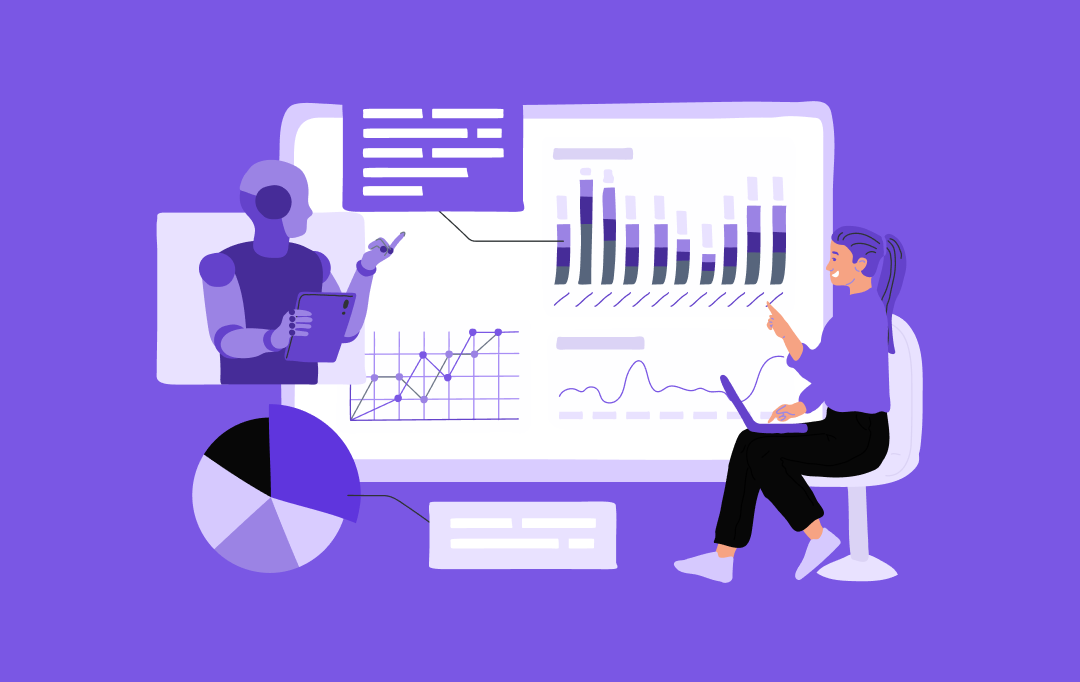- Big Data Analytics Market Overview
- Why Big Data Analytics Matters in Telecom
- Data analytics in the telecom industry: Use cases
- Network optimization
- Predictive churn analysis
- Price optimization
- Attracting new subscriber
- Targeted marketing
- Preventing fraud
- Product development
- Product innovation
- Performing preventive diagnostics
- Recommendation engines
- Real-world examples of telecom companies using big data analytics
- Big Data Analytics: Challenges You Need to Know and How to Tackle Them
- Data Consistency and Quality
- Data Integration
- Scalability and Infrastructure
- Skilled Workforce Shortage
- Security and Privacy Issues
- Future Trends in Big Data Analytics for the Telecommunications Industry
- How Appinventiv helped a telecommunication company in their big data journey
- Conclusion
With the increasing use of smartphones and other connected mobile devices, there has been a surge in the amount of data flowing through the networks of telecom operators. They need to rapidly store, process and extract useful insights from the available data.
This is where big data analytics comes into play.
Big data can help telecom companies to increase profitability by helping optimize network usage and services, enhance customer experience, and improve security.
Big data also provides the telecommunications industry with access to new opportunities. It can improve the quality of service and routing traffic more effectively. By analyzing call data records in real-time, tele companies can also identify fraudulent behavior and act on them immediately. This ultimately gives them a competitive advantage in the market and helps uncover hidden potential.
While you must have got a brief idea about why big data analytics is important for telcos, in the next sections, let us discuss in detail the use cases of big data in the telecom sector and its countless benefits for the telecom companies.
But before dwelling into the use cases, let us have a brief overview of the global big data analytics market to understand why it is important for your business to tap into the growing market.
Big Data Analytics Market Overview
As per Valuates Reports, the global big data analytics market is projected to reach USD 684.12 billion by 2030 from USD 198.08 billion in 2020 growing at a CAGR of 13.5% during the forecast period.
The increased adoption of data analytics by various sectors to reduce costs and deliver faster and enhanced decision-making by analyzing and acting on information in a timely manner is driving the big data market growth.

Why Big Data Analytics Matters in Telecom
The telecom industry is changing due to big data analytics, which allows operators to make decisions based on data, improve their network performance, and provide better customer experience. Telecommunication companies produce enormous amounts of information on call records, network traffic, customer interactions, and the Internet of Things.
Through this data, operators can identify network bottlenecks, predict service disruptions, and optimize bandwidth allocation to enable their customers to experience smoother connectivity and improved quality of service.
Moreover, big data analytics enables telecom companies to comprehend customer behavior, create personalized offerings, and minimize churn. At-risk subscribers can be recognized by predictive models and proactive retention strategies applied, and usage patterns can be used to design targeted promotions and plans.
In general, the use of big data analytics can enable telecom businesses to enhance their operational efficiency, generate revenue, and sustain a competitive advantage in an ever-evolving market.
Data analytics in the telecom industry: Use cases
Big data has become important to drive progress in the telecommunication industry. With the right data analytics approach, telecommunication companies can dramatically improve their services and make their subscribers happier.
Companies and enterprises that implement big data analytics can reap several benefits such as informed decision-making, improved customer service, and efficient operations.
Here are some major big data applications in the telecommunications industry through which your business can reap the numerous benefits of the technology.

Network optimization
The telecom industry is starting to leverage big data analytics to monitor and manage network capacity effectively, build predictive capacity models and use it for planning network expansion decisions.
With real-time data analytics, the telecom service providers can determine highly congested areas where network usage is nearing its capacity thresholds to prioritize expansion for new capacity roll out.
Based on real-time analytics, they can also develop predictive capacity forecasting models and plan for additional capacity in case of outages.
Data analytics for telecom can also help detect anomalies and ensure that the network systems execute in a secure, reliable, and efficient manner.
Predictive churn analysis
It takes a lot of effort to engage customers for a long time. Every year a large number of customers in the US stop taking services from their telecom provider due to reasons like poor customer service.
Analyzing the behavior of customers and taking actions accordingly is crucial to prevent customer churn. Data analytics can help continuously monitor and manage any drop in service performance, model network behavior, and map future demands.
It also helps understand customer preferences and identify issues like churn risks by accurately analyzing hundreds of data points and millions of network usage patterns. According to Mckinsey & Company, the telecom industry can predict and reduce customer churn by 15% using advanced data analytics.
For example, data analytics in the telecom industry can help operators proactively reach out to high-value customers who have experienced a series of quality issues or reported negative experiences regarding the service on social media.
This would help service providers to address the issues and offer discounts or service credits to prevent customers from leaving their services.
Also read: Big Data Analytics in the Oil and Gas Industry – Benefits, Use Cases, Examples, Challenges
Price optimization
With the rising competition in the market to attract more subscribers, it has become crucial for telecom operators to set optimal prices for their products and services.
With the help of data analytics, telecom operators can gain accurate data insights and create optimal pricing strategies by analyzing customers’ reactions to different pricing strategies, purchase history, and competitor pricing.
In addition, telecom providers can maximize their ROI, identify the perceived value of their product or services, and improve their sales team’s effectiveness.
Optimizing the pricing strategy based on profit and revenue earned can boost sales, help gain more customers, and most importantly, retain loyal customers.
[Also Read: How Much Does It Cost to Develop a Telecom App Like My WE?]
Attracting new subscriber
Big data for telecom industry helps companies retain customers and attract new subscribers by offering new services and content. But how do they know what their customers want? Big data analytics helps telecom companies to build a customer persona and guess the needs and interests of their customers.
The right content and flexible offerings retain old customers, attract new ones, and increase operator’s revenues.
Let’s take Netflix for example. It earns up to 75% on purchases offered by a recommendation system based on both personalized and collaborative algorithms.
Targeted marketing
Big data solutions help understand customer behavior by reviewing how they use the services offered by the telecom. A detailed analysis of purchase history, service preferences, and customer feedback enables customized product offering to target the right audience at the right time.
This way, they can develop personalized offers and advertising deals for customers, maintain competitive advantage, continue steady development, and improve conversion rates.
Preventing fraud
Based on industry estimates, telcos annually lose approximately 2.8% of their revenues to leakage and fraud, costing the industry approximately US $40 billion every year.
Big data analytics can protect the telecommunication industry against such fraud. It can recognize phrases typical of cybercriminals and intercept spam mailings and calls. For instance, a Chinese mobile operator launched an app called Sky Shield, which utilizes big data and AI technologies to prevent fraud in the telecom sector.
The police provided the developers with a database of fraud cases that helped Sky Shield to recognize fraudulent communication behavior, differentiate it from normal calls, and intercept spam calls and texts.
[Also Read: How machine learning helps in financial fraud detection]
Product development
There’s no denying that developing a product is a complex process that requires control and careful management. Integrating data analytics can ensure the product’s high-quality performance according to the customer’s requirement.
Data analytics for telecom helps in the data-driven product development process, internal feedback, and marketing intelligence.
Product innovation
The real-time data from multiple sources can be used to improve the products offered by telecom. They can also analyze customer usage to develop new and innovative products that will serve users’ needs and save money.
One of the perfect examples of such an innovative feature offered by telecom is the ability to use their Wi-Fi service from anywhere. The customer only needs to log in, and they can use the Wi-Fi whether they are at home, in a restaurant, a coffee shop, or at the airport.
Performing preventive diagnostics
Using data analytics telcos can identify patterns of system behavior that precede the occurrence of failures and determine the causes of such failures.
Early diagnosis helps operators to plan preventive maintenance, replace and repair equipment.
Predictive analytics based on big data can also help the operators to analyze the intentions of their customers by taking information from their social networks. Big data also allows telecom providers to find influencers among their customers.
Recommendation engines
The recommendation engine is a set of smart algorithms that indicates the customer’s behavior. On the basis of that behavior, it predicts the future needs of customers. Recommendation engines make use of both collaborative filtering and content-based filtering approaches.
Content-based filtering uses the attributes that show the relationship between the customer profile and the product or service a customer chooses. Collaborative filtering, on the other hand, relies on the analysis of data according to the user’s preferences and behavior.
Real-world examples of telecom companies using big data analytics
Big data is a fuel that can and will drive the entire telecom industry towards better customer service and higher revenue. A few big telecom companies have already started leveraging big data analytics to improve their quality of service and get better insights into consumer behavior.

Here are a few real-world examples of telecom companies that have been utilizing big data to their full advantage.
Vodafone: Vodafone has been leveraging big data and artificial intelligence to understand customer preferences better and deliver instant customer services. By integrating data analytics, Vodafone has been able to track the voice and data consumption behavior of users and offer the most appropriate plan or pack options to them.
( Also read: AI in Telecom – Exploring the Key Business Benefits, Use Cases, Examples and Challenges)
Reliance Jio: With the help of big data, Jio acquired 130 million customers within one year of its launch. While other companies have been underestimating the power of big data, Jio used it to its full advantage and successfully established an empire in the telecom world. They are making use of big data analytics to get a real-time and location-based view of users. Data analytics has also helped Jio to collect data on consumer habits, which ultimately helps them to enhance customer experience.
Now that we have looked into how companies use big data to accelerate growth, let’s see how our experts can help in your big data journey.
Big Data Analytics: Challenges You Need to Know and How to Tackle Them
Big data analytics is potentially a potent insight into the business, though it has multiple challenges. Every challenge would be dealt with in practical solutions so that there would be a successful adoption. Here are some of them:
Data Consistency and Quality
Challenge: Data that is inconsistent, missing or inaccurate will diminish the utility of analytics. The low quality of data causes erroneous insights and poor business decisions.
Solution: Adopt powerful data governance procedures which involve data cleansing, validation and standardisation of all the sources. Keep data integrity with the help of automated tools.
Data Integration
Challenge: Data in organizations is usually distributed across various systems, databases, and formats thus integration becomes challenging.
Solution: Consolidated information using ETL (Extract, Transform, Load) tools or data lakes. Make use of open standards and APIs to simplify integration and guarantee interoperability.
Scalability and Infrastructure
Challenge: Handling large quantities of data requires robust infrastructure, which can be economically demanding and complex to operate.
Solution: Take advantage of demand-scaling cloud-based analytics services. Select distributed processing models, such as Hadoop or Spark, to compute with big data effectively.
Skilled Workforce Shortage
Challenge: Skilled professionals who would be able to manage, analyze, and interpret big data are lacking.
Solution: Invest in existing employee training and think of a special data scientist or an analytics consulting agency. Promote cross-functional teams to work together to get a greater understanding.
Security and Privacy Issues
Challenge: The information stored in big data systems is sensitive, which increases the risk of breaches, non-compliance with regulations, and the disappearance of customer confidence.
Solution: Adopt powerful encryption, access controls, and anonymization. Make sure that you are complying with laws regarding the protection of data (e.g., GDPR in the EU/UK) and perform regular security audits.
Future Trends in Big Data Analytics for the Telecommunications Industry
By 2025, telecom operators will be more and more dependent on big data analytics to remain competitive, as well as provide outstanding customer experiences. The fast changes in technology, increasing network pressures, and decision-making based on data are transforming the manner in which telecom companies operate, manage networks, and interact with subscribers. Key trends to watch include:
AI and Machine Learning Integration: Predictive analytics and AI-based automation will enable the telecom industry to achieve higher network performance, prevent outages, and deliver customized services.
Generative AI in Service Innovation: AI-based suggestions will improve content generation, software applications, and business processes, which will increase the speed of innovation in telecommunications services.
5G and Edge Computing Analytics: Edge processing of data will help empower smarter IoT applications, low-latency services, and improve mobile experience.
Better Customer Experience Data: Insights with analytics will enable operators to create custom plans, anticipate churn, and have hyper-personalized promotions.
Sustainability and Reduced Energy Consumption: Big data will help telecoms monitor their energy consumption, optimize network operations, and implement green infrastructure practices.
How Appinventiv helped a telecommunication company in their big data journey
We recently helped one of our clients in the telecom sector to enhance data quality and consistency by offering them data analytics services. Our first step was to store and analyze data on the cloud using a broad spectrum of Apache technologies.
This helped us to streamline the unwanted data cluster and analyze and prioritize data on one centralized platform in real-time. Our data analytics approach, coupled with ETL tools, resulted in a master repository that provided a 360-degree overview of our client’s 90 million+ customers.
We followed an agile methodology to create an ecosystem that could process high volumes of data and classify it according to customer behavior and preferences.
The result? Our dedicated efforts led to an 85% increase in data quality and accessibility and 100% availability of customer data to every department of the organization.
Also read how cloud computing helps telecom companies to grow and sustain.
Conclusion
The advantages of using big data in telecom are countless. From improving customer experiences to offering clear insights into business trends, the implementation of big data analytics services can enhance your business’s overall proficiency and effectiveness.
Speaking of trends, Explore the top 5 trends shaping the future of data infrastructure in 2022 and beyond
At Appinventiv, our team of data analytics experts partners with you to implement advanced big data solutions, addressing your data challenges comprehensively. We transform unstructured data into actionable insights, empower data-driven decision-making, and equip your organization to stay ahead in a competitive landscape.
Plus, we’re poised to help you leverage the potential of 6G, ensuring your business harnesses this next-gen technology for even greater competitive advantage. Hire our experts. We will have all your needs covered!
FAQs
Q. What data points matter most in the telecom industry?
A. Some of the major data points that matter the most in the telecom industry include:
Call Detail Records (CDRs): Length, frequency, and categories of calls to be used.
Network Performance Metrics: Network latency, network throughput, packet loss, and congestion.
Patterns of customer usage: Patterns of data consumption, patterns of app usage, and hours of peak usage.
Subscriber Demographics and Preferences: Age, location, device type, and preferences on the type of service.
IoT and Device Data: Network load and service optimization data of connected devices.
Customer Support Data & Feedback: Service tickets, complaints, and social sentiment.
Q. How can telecoms support real-time analytics at the network edge?
A. Telecoms can also place edge computing nodes near end users to decrease the latency and allow real-time data processing. Operating analytics on the edge gives operators the ability to provide faster insights into applications like IoT, autonomous systems, and video streaming, and offload core networks.
Q. How can telecoms leverage big data from connectivity platforms for business growth?
A. Connectivity platforms generate massive usage, place, and device data. Telecom can use this information to determine the behavioral pattern of clients, develop personal services, optimise pricing, and generate new sources of revenue by creating target-based partnerships, along with solutions based on data.
Q. How can telcos benefit from distributed real-time data stores?
A. Distributed real-time data stores enable the telcos to coordinate high-velocity data in different geographical areas in a consistent and speedy manner. This aids application scenarios, such as fraud detection, network monitoring, and dynamic resource allocation, to assist operators in achieving reliability as they scale services to a global scale.
Q. What platforms use usage data to optimize service plans?
A. Here are some of the top platforms:
CRM & BI Platforms: Salesforce, Microsoft Dynamics, and Tableau are used to analyze usage to create customer segments.
Telecom Analytics Platforms: Nokia NetAct, Ericsson Network Manager, and Cisco Analytics for service optimization.
Cloud-Based Big Data Tools: AWS Redshift, Google Big Query, and Azure Synapse can consolidate the use of data to propagate the plan recommendations.
AI-Powered Customer Insights: IBM Watson or SAS Analytics tools integrate the usage, billing, and support data to recommend the best plans and promotions.


- In just 2 mins you will get a response
- Your idea is 100% protected by our Non Disclosure Agreement.

How to Hire Data Engineers for Your Enterprise? All You Need to Know
Key takeaways: Hiring data engineers individually slows execution and increases delivery risk at enterprise scale. Partnerships give faster access to senior talent without long recruitment cycles or retention issues. Cost depends more on capability and responsibility than salary alone. The right hiring model directly affects business speed, stability, and ROI. Partnering with experienced teams converts…

How Data Analytics is Shaping the Future of UK Businesses Across Sectors
Key Takeaways Data has moved from support to strategy. UK companies no longer treat analytics as an add-on; it’s shaping how they forecast demand, design products, and compete for customers. Every sector is finding its own rhythm. From retail and healthcare to energy and education, organizations are using data differently, but the goal is the…

Is Your Business Model Compliant with the EU Data Act? A Checklist for C-Suite Executives
Data has quietly become the backbone of modern business. Whether it’s a retailer predicting what you’ll buy next week or a car maker tracking vehicle performance in real time, every decision today leans on streams of information. But with that power comes a tough question: who really owns the data, and who gets to use…




































